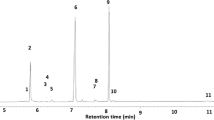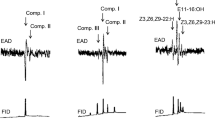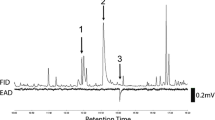Abstract
The sex pheromone released by the adult female Tenebrio molitor, 4-methyl-1-nonanol, is well known. In addition, there is evidence that adult males release a pheromone that attracts females. The purpose of the present study was to isolate and identify male-released pheromone(s). Emissions from virgin adult males and females were collected on filter paper and extracted with pentane. Extracts were analyzed by gas chromatography-mass spectrometry. One male-specific compound was detected and identified as (Z)-3-dodecenyl acetate (Z3-12:Ac). In arena bioassays, E3-12:Ac was attractive to females only, at 1 and 10 μg doses. E3-12:Ac was also attractive to females at a 10-μg dose. The presence of both male and female pheromones, each attracting the opposite sex, may contribute to maintaining a high-density population of both sexes.


Similar content being viewed by others
References
C. J. August (1971) ArticleTitleThe role of male and female behaviour of Tenebrio molitor J. Insect Physiol. 17 739–751 Occurrence Handle10.1016/0022-1910(71)90120-X
A. K. Bhattacharya J. J. Ameel G. P. Waldbauer (1970) ArticleTitleA method for sexing living pupal and adult yellow mealworms Ann. Entomol. Soc Am. 63 1783
J. Chambers (1991) ArticleTitleOverview of stored-product insect pheromones and food attractants J. Kans. Entomol. Soc. 63 490–499
R. T. Cotton (1956) Pests of Stored Grain and Grain Products Burgess Publishing Minneapolis, MN
D. Finnegan J. Chambers (1993) ArticleTitleIdentification of the sex pheromone of the Guernsey carpet beetle, Anthrenus sarnicus Mroczkowski (Coleoptera: Dermestidae) J. Chem. Ecol. 19 971–983 Occurrence Handle10.1007/BF00992532
G. H. Gerber (1973) ArticleTitleReproductive behaviour and physiology of Tenebrio molitor (Coleoptera: Tenebrionidae). I. Initiation of mating in young adults and the effects on adult density Can. Entomol. 105 807–811
G. M. Happ (1969) ArticleTitleMultiple sex pheromones of the mealworm beetle, Tenebrio molitor L Nature 222 180–181 Occurrence Handle5777043
G. M. Happ J. Wheeler (1969) ArticleTitleBioassay, preliminary purification, and effect of age, crowding, and mating on the release of sex pheromone by female Tenebrio molitor Ann. Entomol. Soc. Am. 62 846–851
R. Keville P. B. Kannowski (1975) ArticleTitleSexual excitation by pheromones of the confused flour beetle J. Insect Physiol. 21 81–84 Occurrence Handle10.1016/0022-1910(75)90070-0 Occurrence Handle1120916
W. Mordue (1965) ArticleTitleStudies on oöcyte production and associated histological changes in the neuroendocrine system in Tenebrio molitor L J. Insect Physiol. 11 493–503 Occurrence Handle10.1016/0022-1910(65)90054-5 Occurrence Handle14288377
B. F. Nesbitt P. S. Beevor A. A. Cork D. R. Hall R. M. Murillo H. R. Leal (1985) ArticleTitleIdentification of components of the female sex pheromone of the potato tuber moth, Scrobipalpopsis solanivora Entomol. Exp. Appl. 38 81–85 Occurrence Handle10.1007/BF00163356
S. Obata T. Hidaka (1982) ArticleTitleExperimental analysis of mating behavior in Tenebrio molitor L. (Coleoptera: Tenebrionidae) Appl. Entomol. Zool. 17 60–66
K. Okada A. Watanabe M. Mori K. Schimazaki T. Chuman F. Mochizuki T. Shibuya (1992) ArticleTitleOlfactory responses to the sex pheromone component and its behavioural inhibitor in the male cigarette beetle, Lasioderma serricorne J. Insect Physiol. 38 705–709 Occurrence Handle10.1016/0022-1910(92)90053-G
D. Rees (2004) Insects of Stored Products Manson Publishing London 112–113
M. Renou C. Descoins J. Y. Lallemand E. Priesener M. Lettere M. Gallois (1980) ArticleTitleL'acetoxy-1-dodecene 3E, composant principal de la pheromone sexuelle de la teigne de la betteravae: Scrobipalpa ocellatella Boyd Z. Angew. Entomol. 90 275–289
W. L. Roelofs (1984) Electroantennogram assays: Rapid and convenient screening procedures for pheromones H. E. Hummel T. A. Miller (Eds) Techniques in Pheromone Research Springer-Verlag New York 131–160
D. Scholz C. Borgemeister H. M. Poehling (1998) ArticleTitleEAG and behavioural responses of the larger grain borer, Prostephanus truncatus, and its predator, Teretriosoma nigrescens, to the borer-produced aggregation pheromone Physiol. Entomol. 23 265–273 Occurrence Handle10.1046/j.1365-3032.1998.233089.x
L. E. Smart A. P. Martin J. L. Cloudsley-Thompson (1980) ArticleTitleThe response to pheromones of adult and newly emerged mealworm beetles (Tenebrio molitor L.) (Coleoptera: Tenebrionidae) Entomol. Mon. Mag. 116 139–145
K. Tanaka K. Ohsawa H. Honda I. Yamamoto (1981) ArticleTitleCopulation release pheromone, Erectin, from the Azuki bean weevil (Callosobruchus chinensis L.) J. Pest. Sci. 6 75–82
Y. Tanaka H. Honda K. Ohsawa I. Yamamoto (1986) ArticleTitleA sex attractant of the yellow mealworm, Tenebrio molitor, and its role in mating behaviour J. Pest. Sci. 11 49–55
W. Tschinkel C. Wilson H. A. Bern (1967) ArticleTitleSex pheromone of the mealworm beetle (Tenebrio molitor) Exp. Zool. 164 81–85 Occurrence Handle10.1002/jez.1401640108
J. M. Valentine (1931) ArticleTitleThe olfactory sense of the adult mealworm beetle, Tenebrio molitor (Linn.) J. Exp. Zool. 58 165–227 Occurrence Handle10.1002/jez.1400580109
M. E. Wakefield G. P. Bryning L. E. Collins J. Chambers (2005) ArticleTitleIdentification of attractive components of carob volatiles for the foreign grain beetle, Ahasverus advena (Watl) (Coleoptera: Cucujidae) J. Stored Prod. Res. 41 239–253 Occurrence Handle10.1016/j.jspr.2004.03.005
P. R. White M. C. Birch (1987) ArticleTitleFemale sex pheromone of the common furniture beetle Anobium punctatum (Coleoptera: Anobiidae): extraction, identification and bioassays J. Chem. Ecol. 13 1695–1706 Occurrence Handle10.1007/BF00980211
Acknowledgments
We thank Dr. Larissa Collins and Mr. A. Prickett for statistical analysis of the behavioral bioassay results. This work was funded under the CSL Seedcorn budget by the UK Department for the Environment, Food, and Rural Affairs.
Author information
Authors and Affiliations
Corresponding author
Rights and permissions
About this article
Cite this article
Bryning, G.P., Chambers, J. & Wakefield, M.E. Identification of a Sex Pheromone From Male Yellow MealWorm Beetles, Tenebrio molitor. J Chem Ecol 31, 2721–2730 (2005). https://doi.org/10.1007/s10886-005-7622-x
Received:
Accepted:
Published:
Issue Date:
DOI: https://doi.org/10.1007/s10886-005-7622-x




